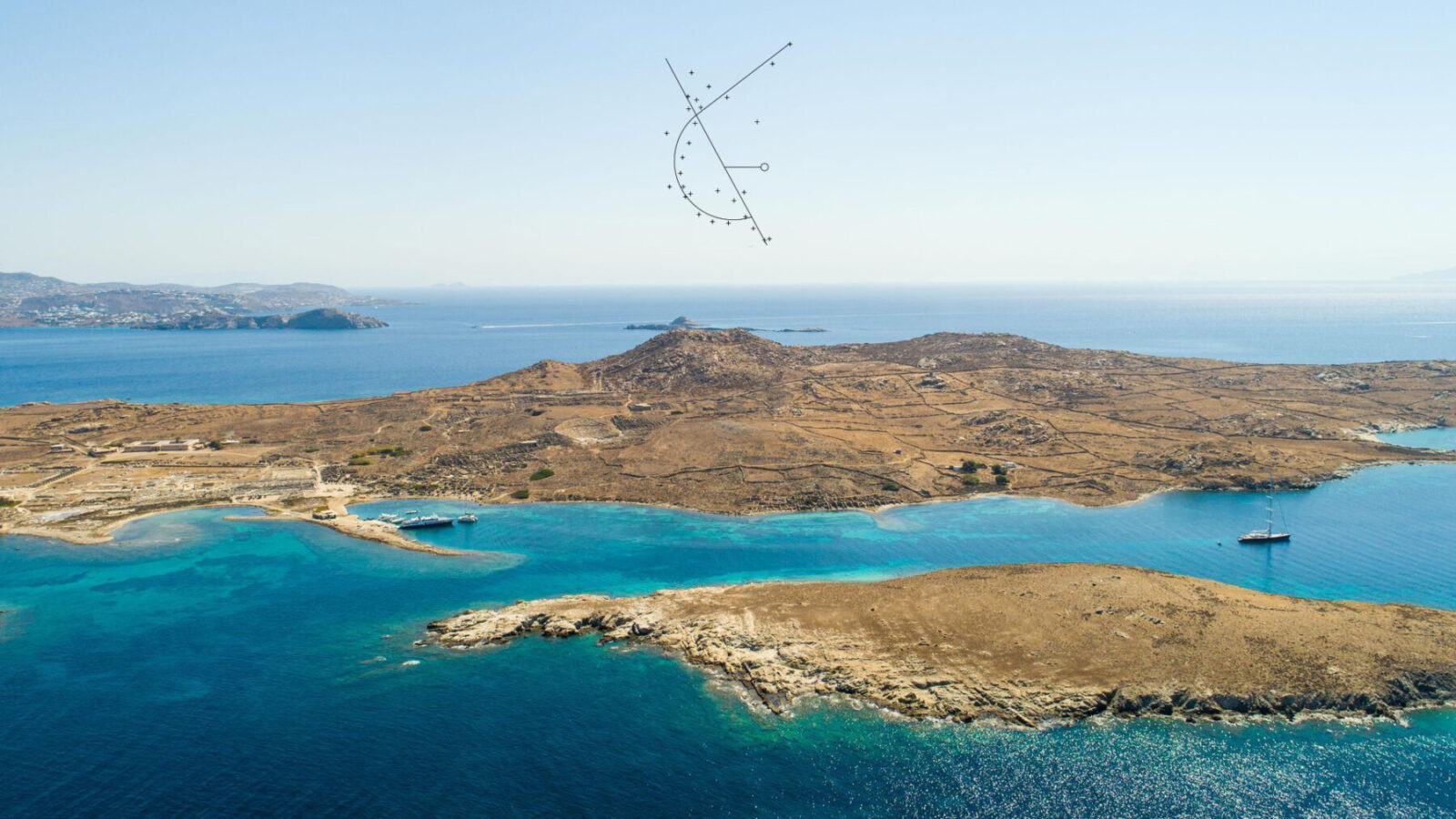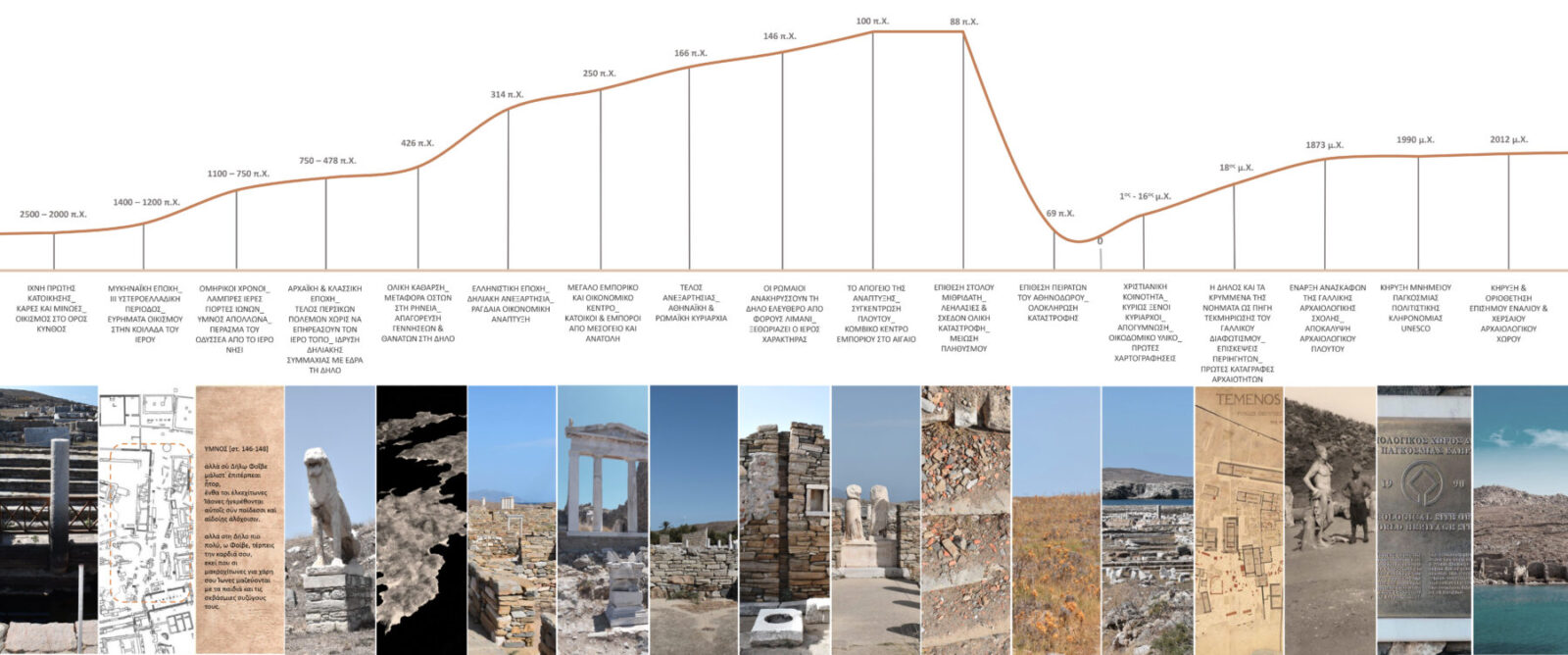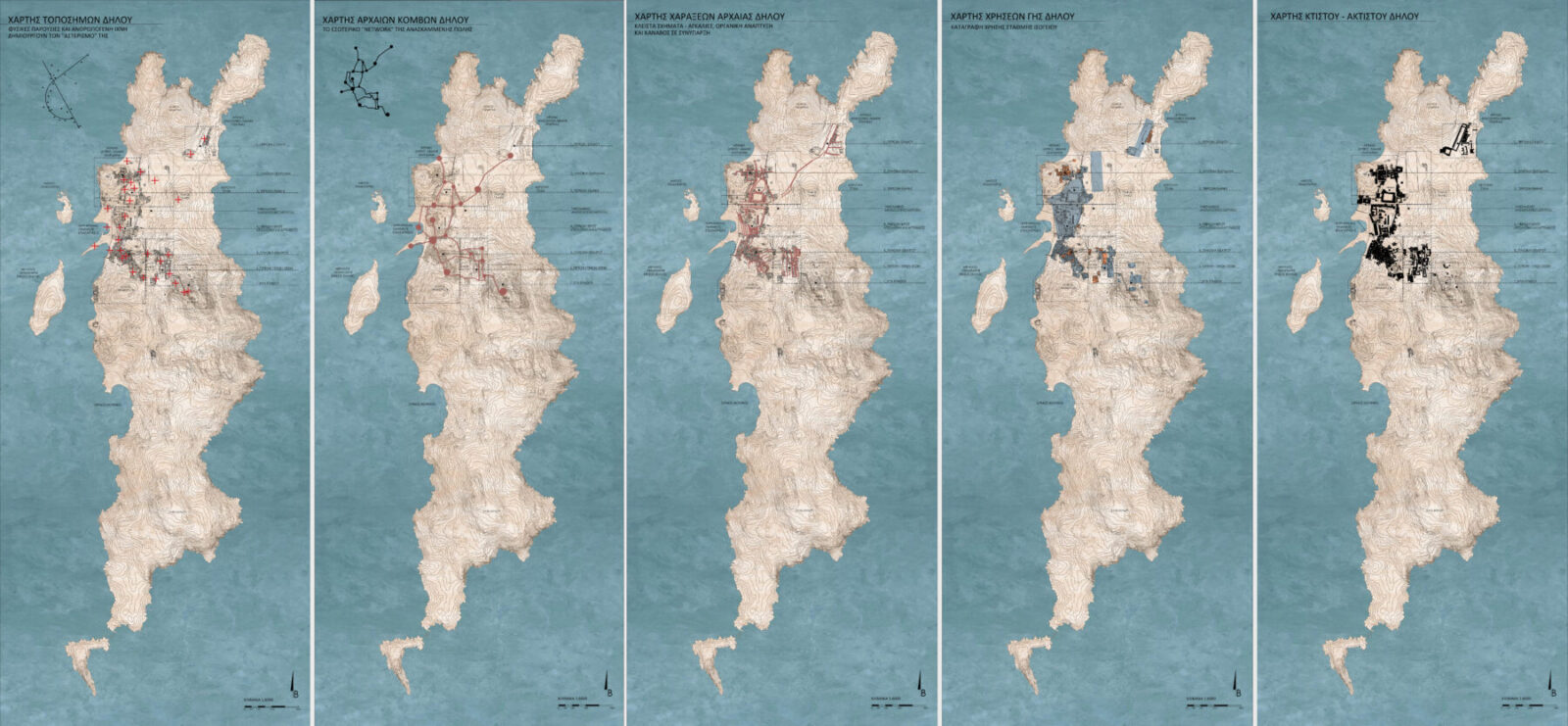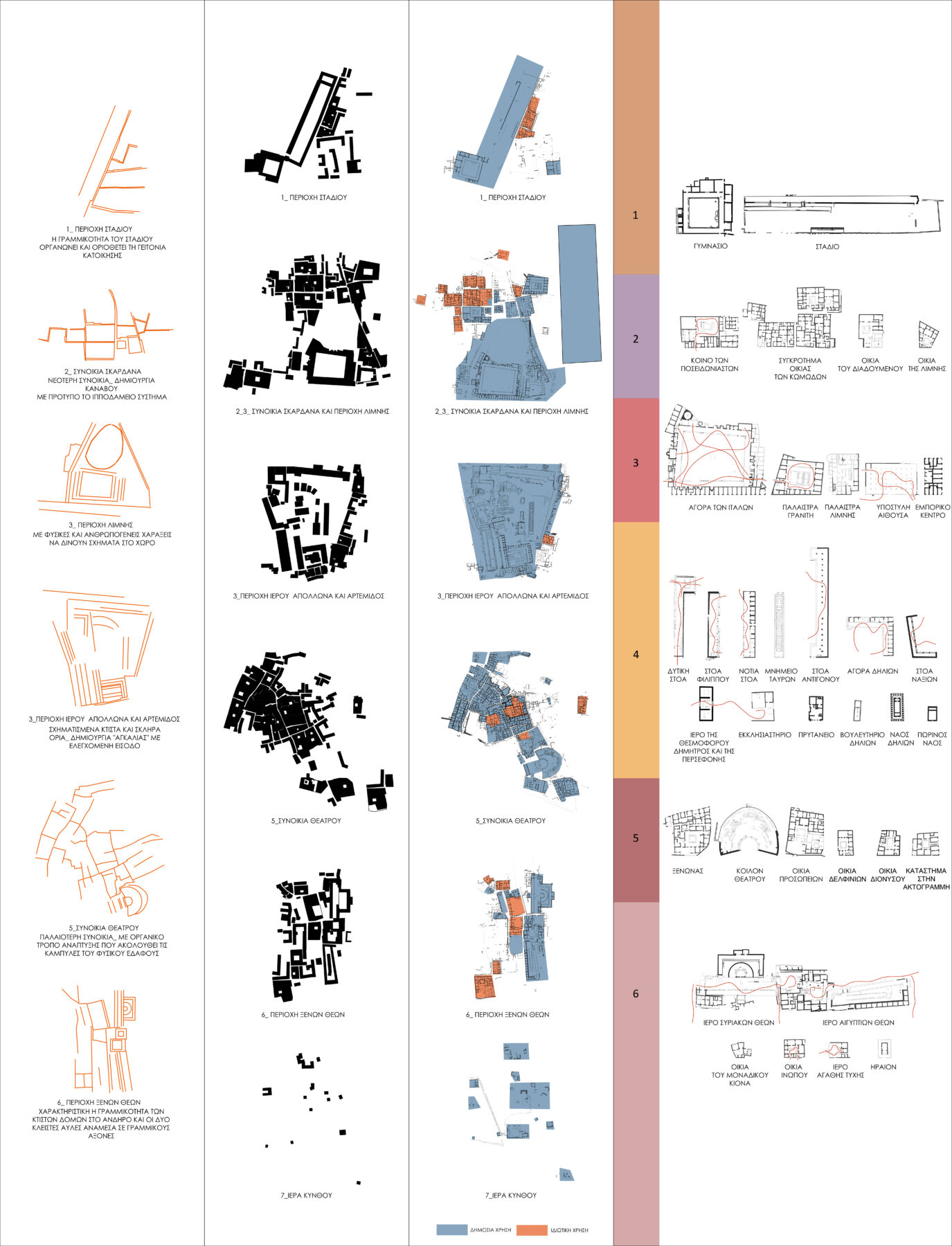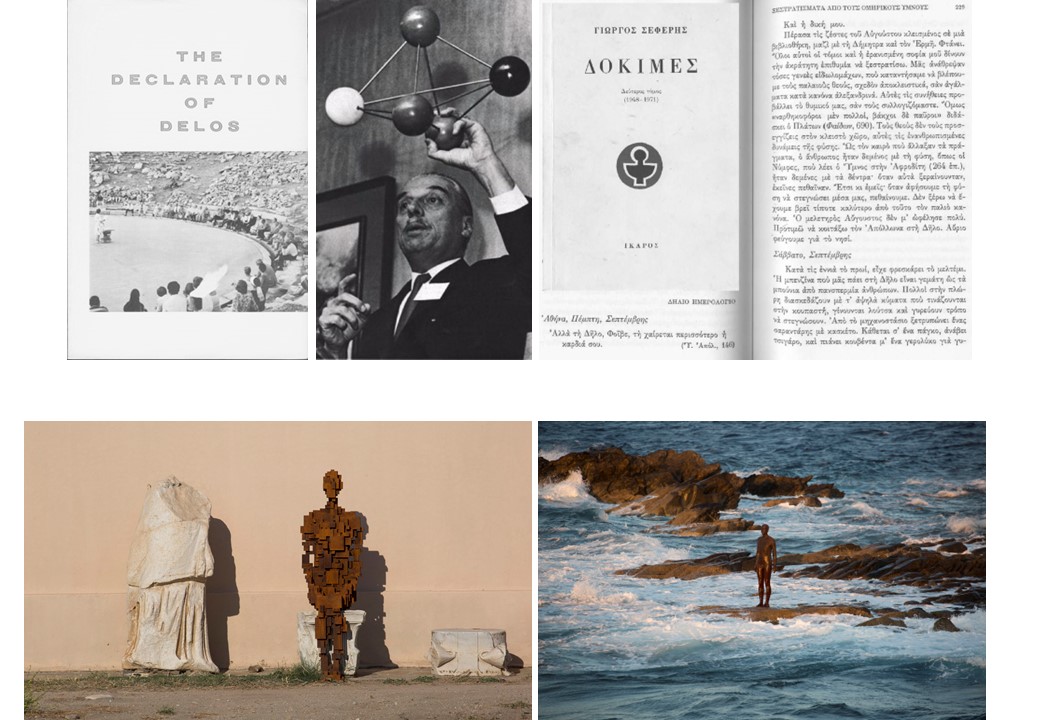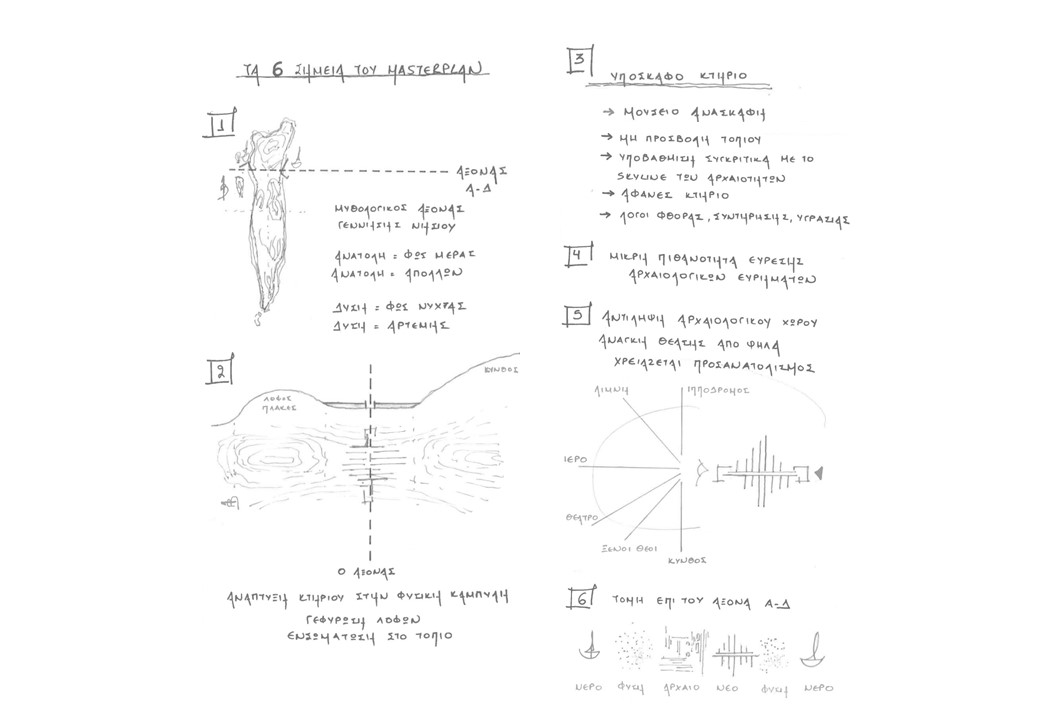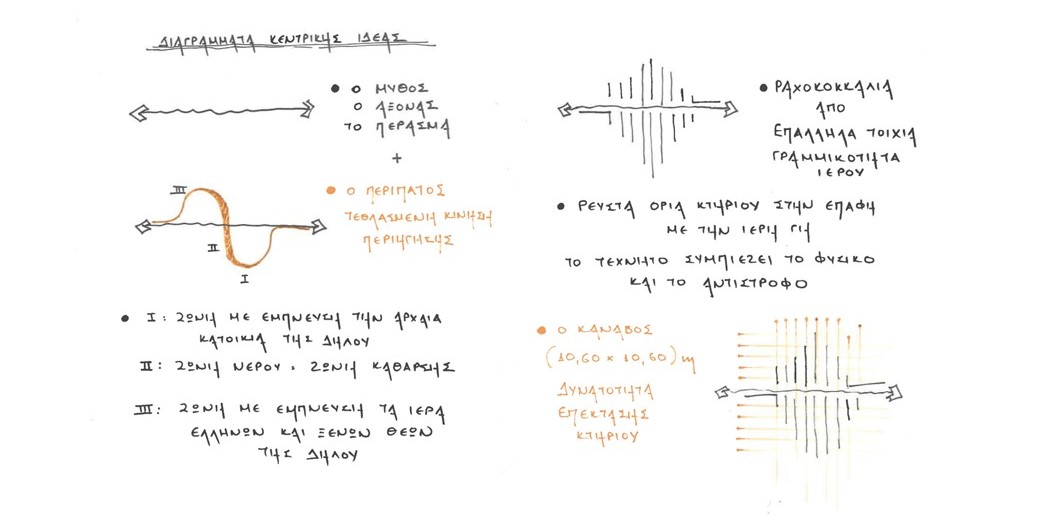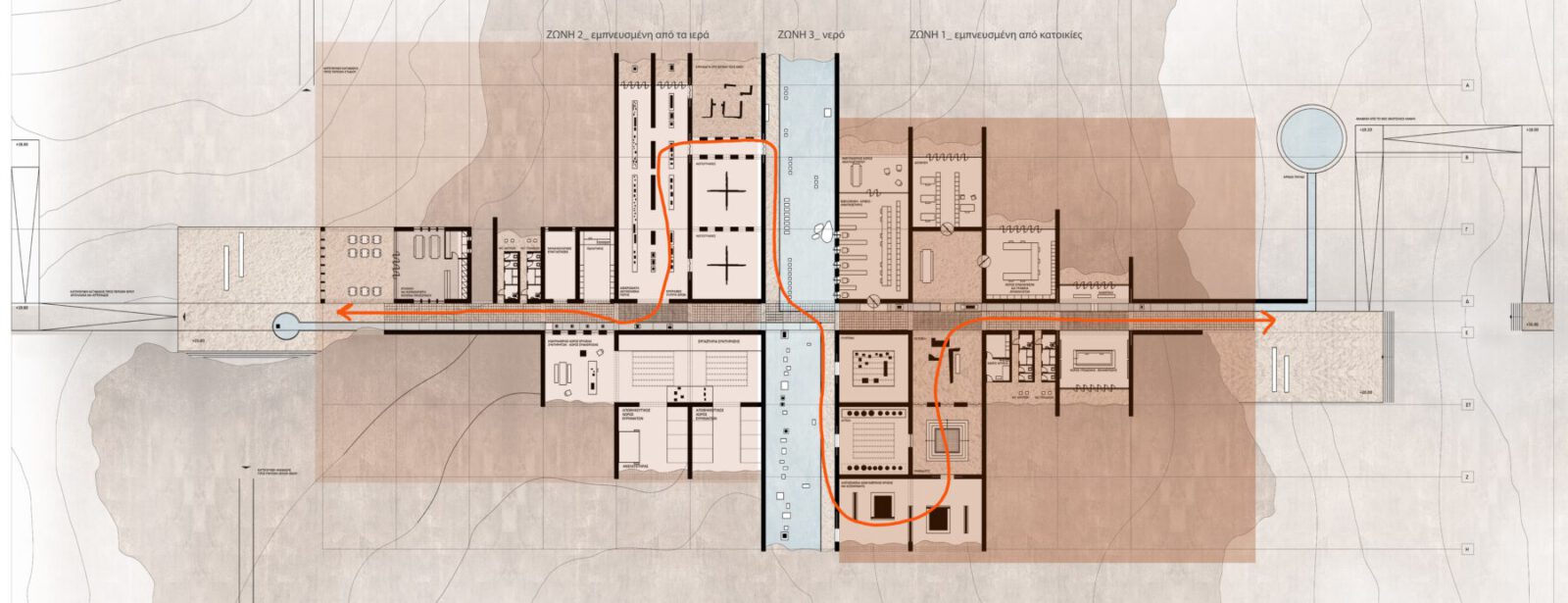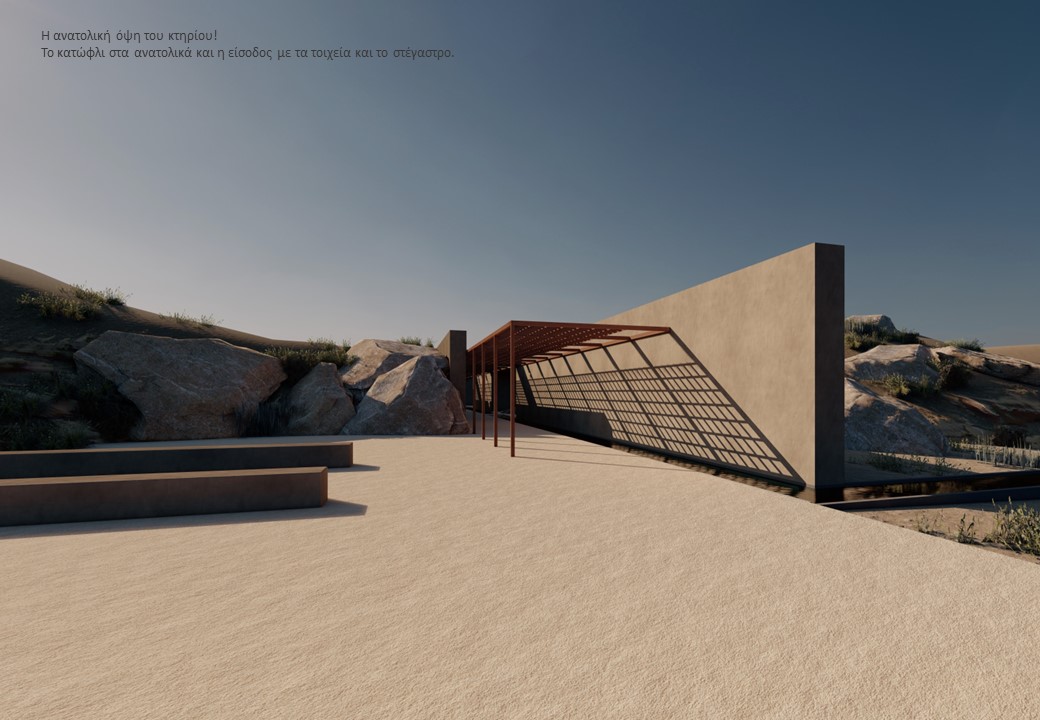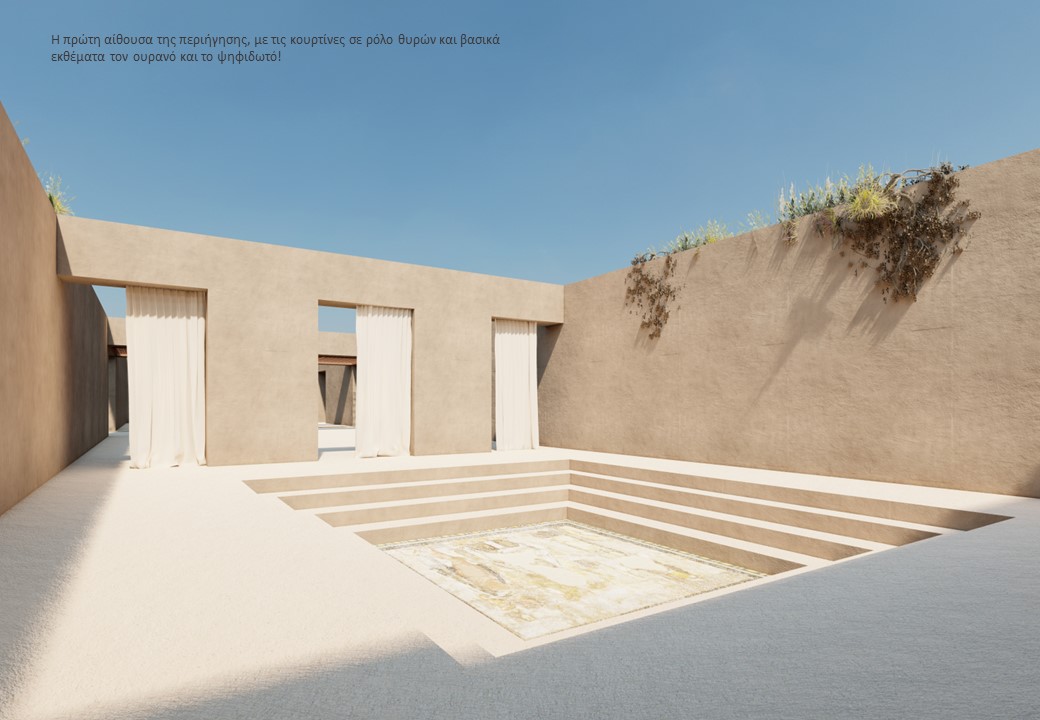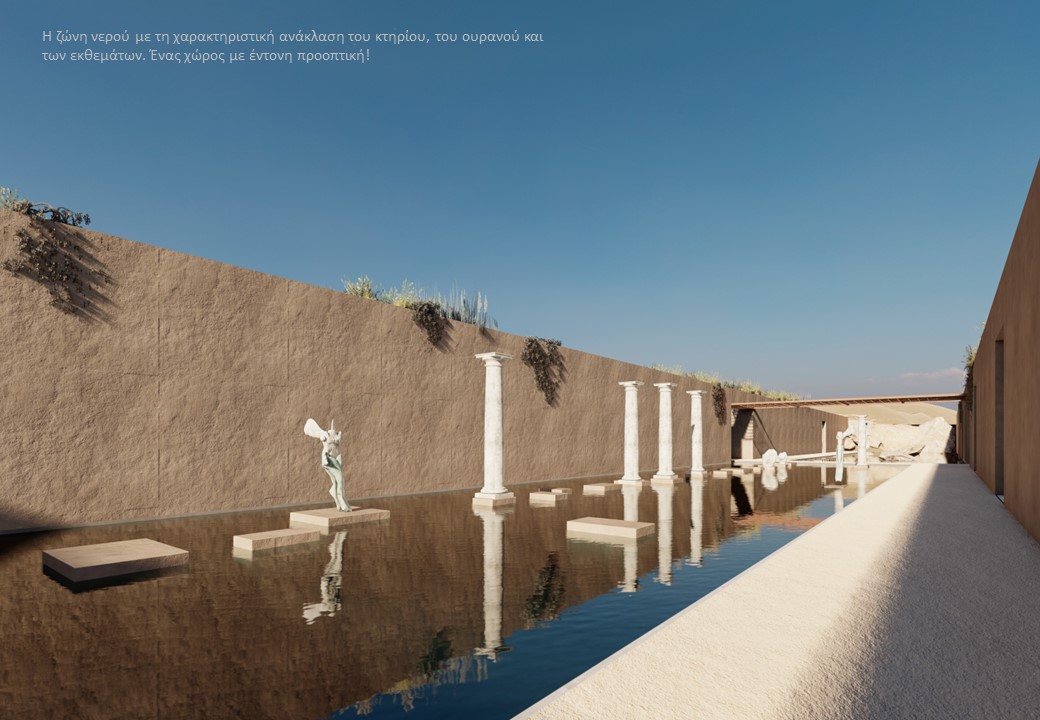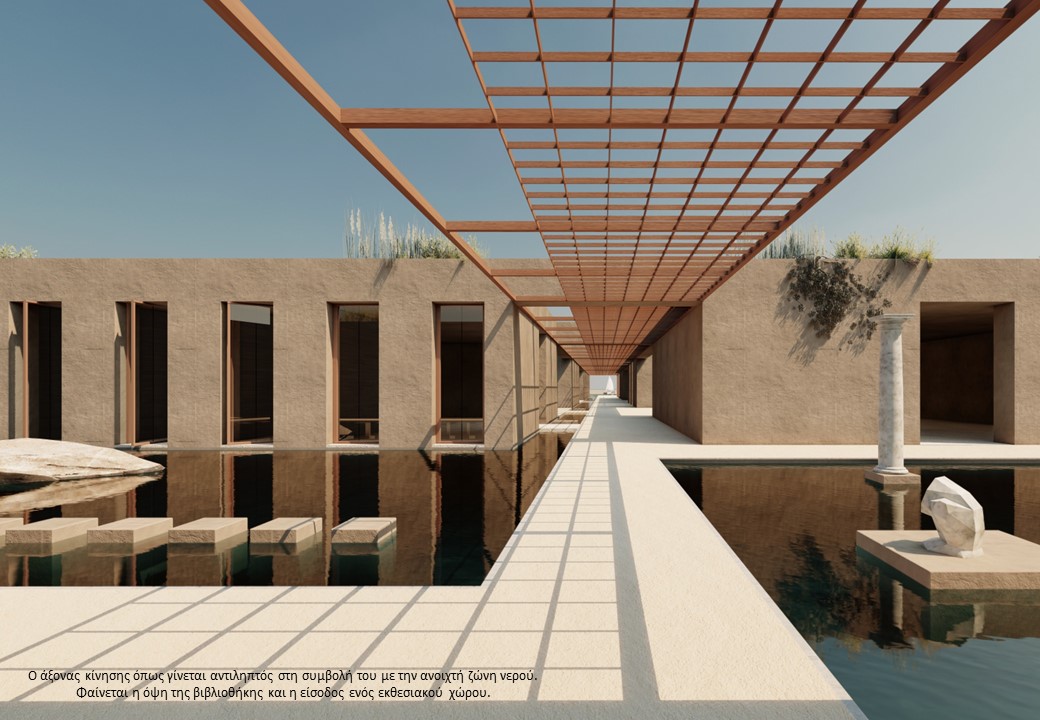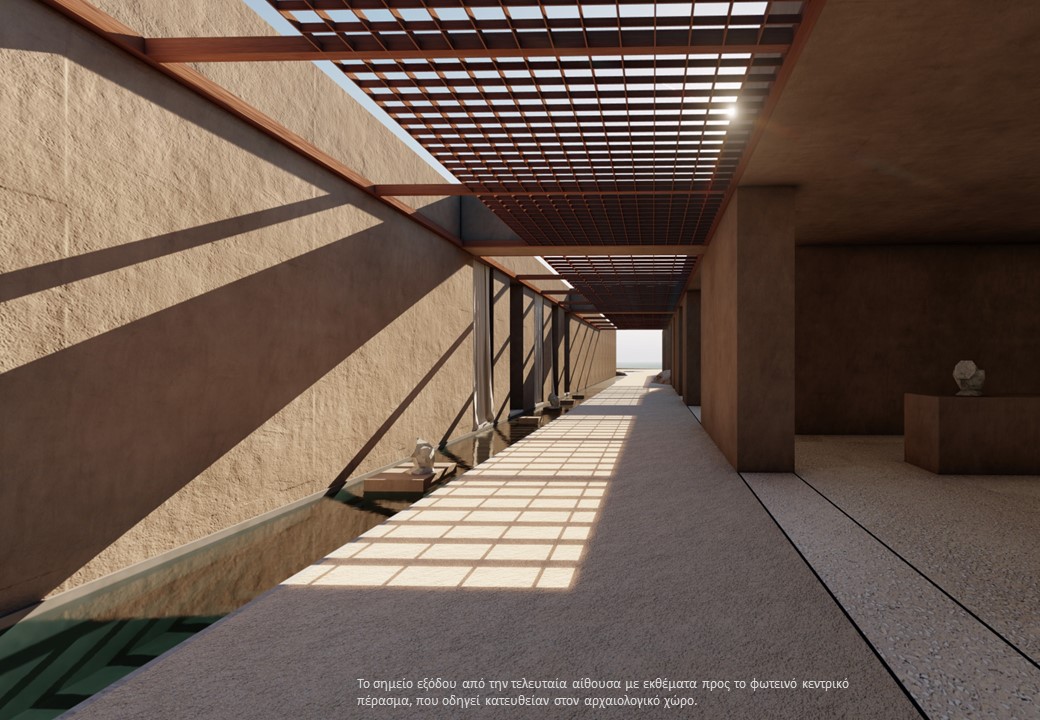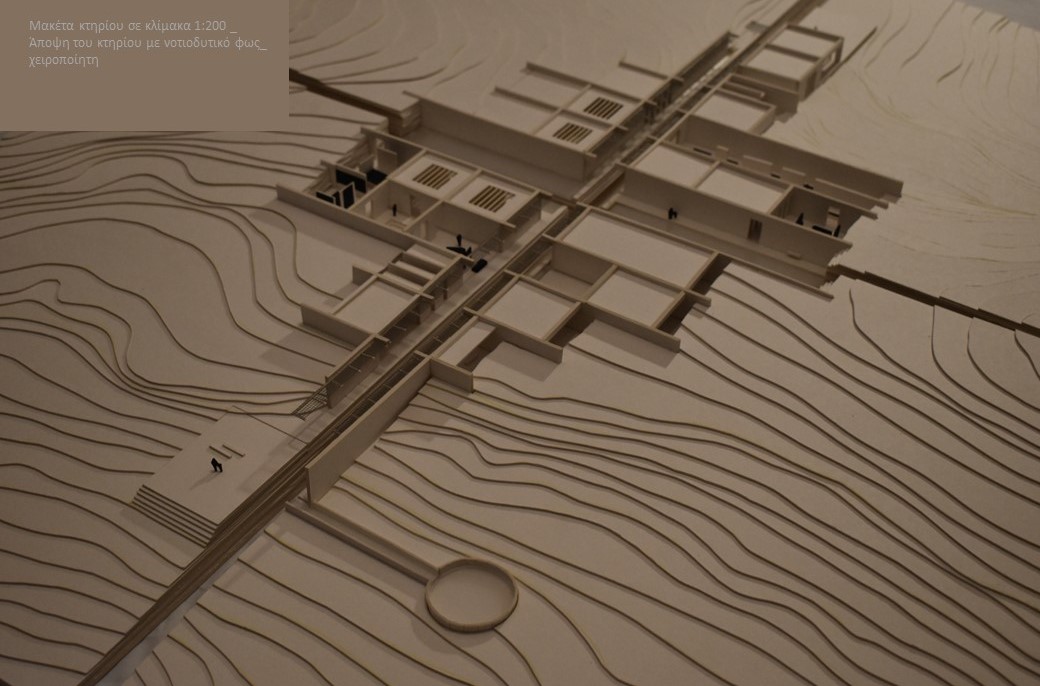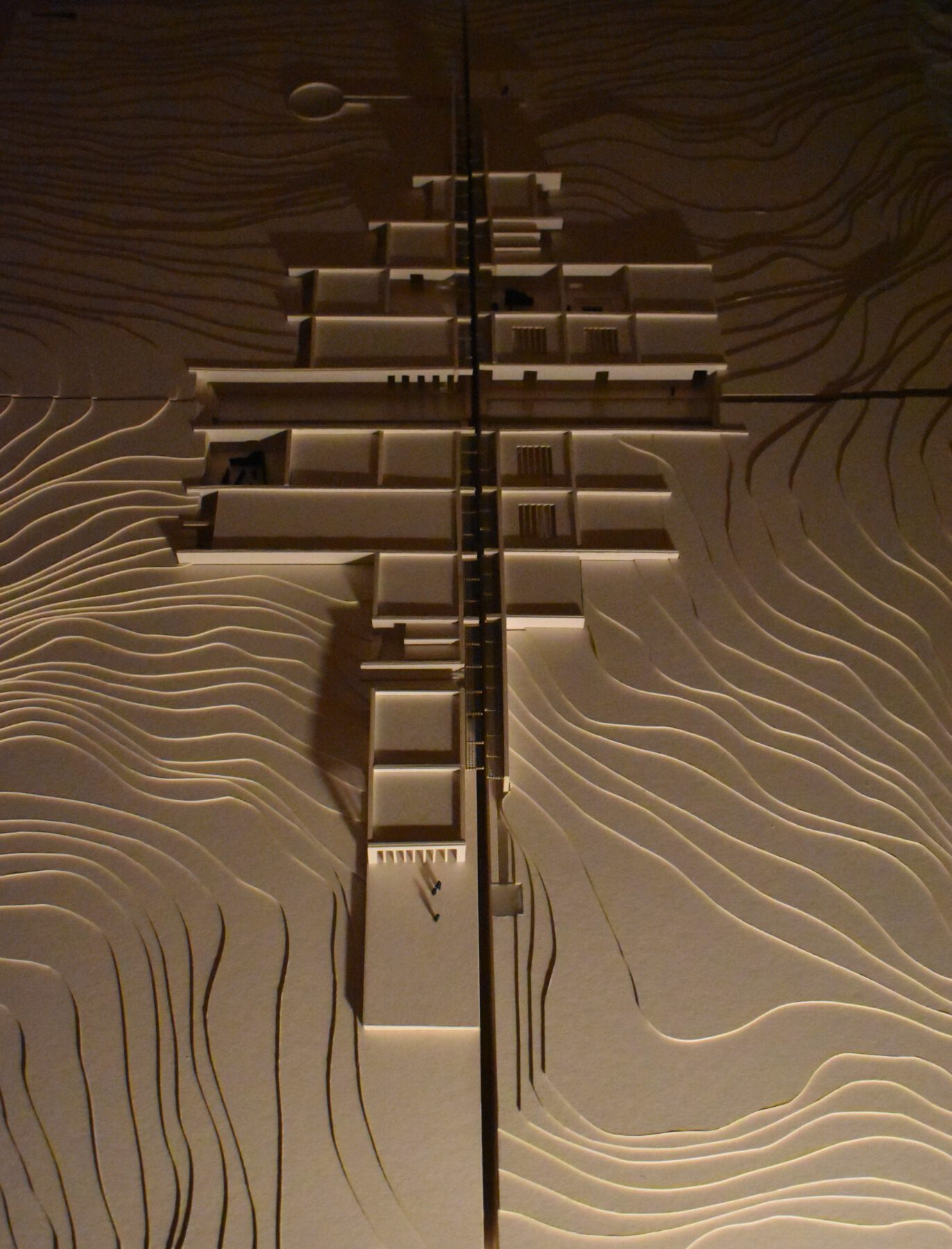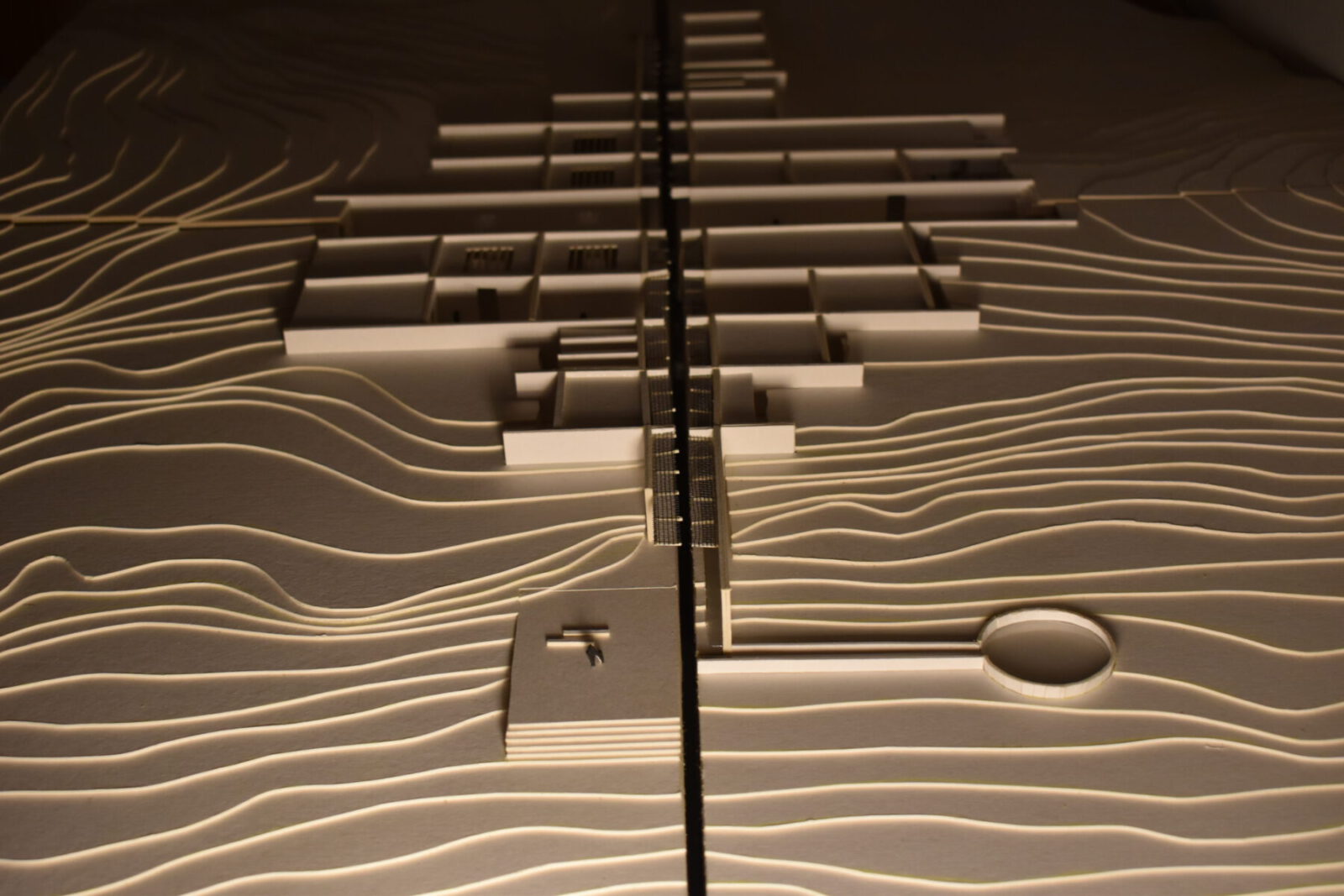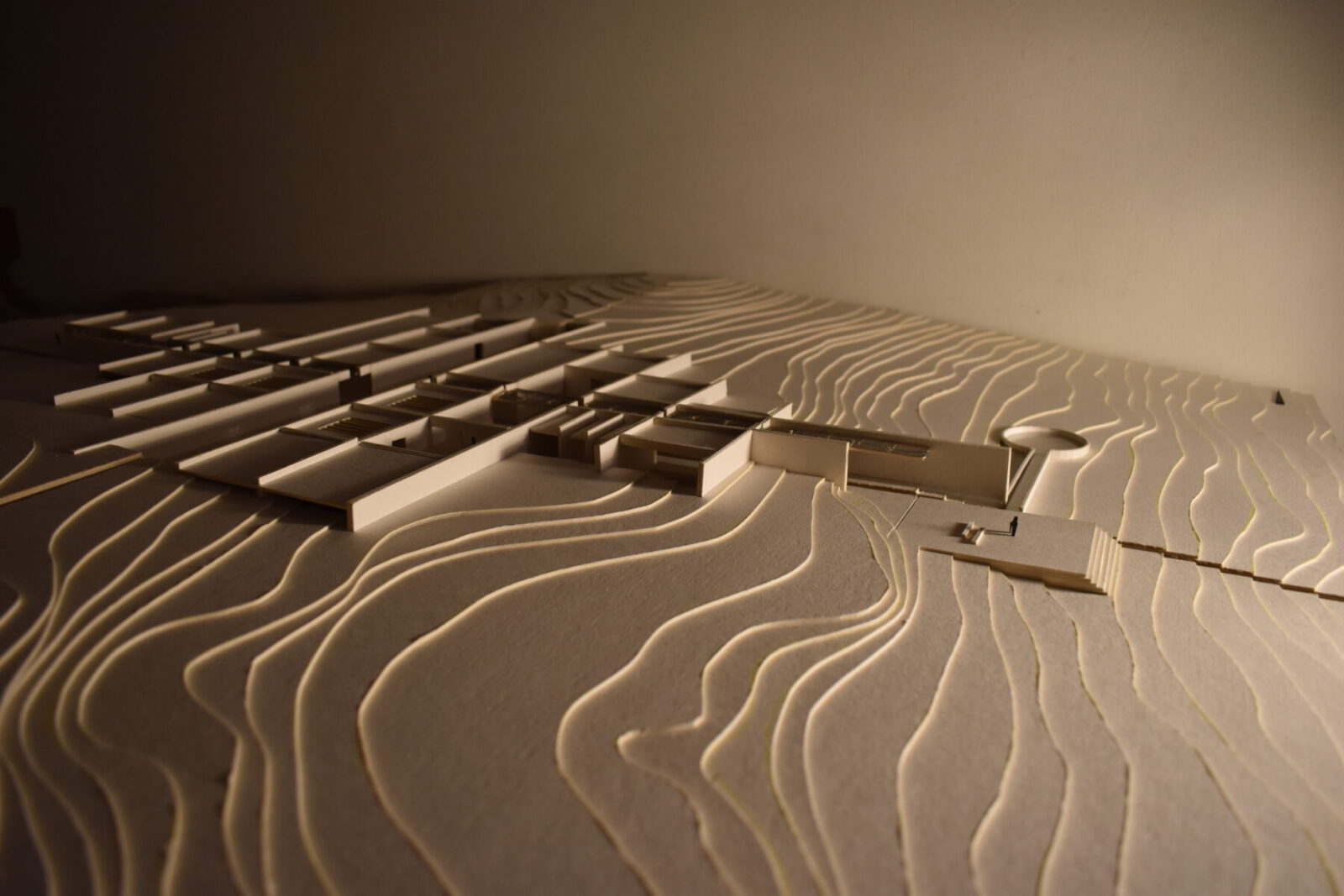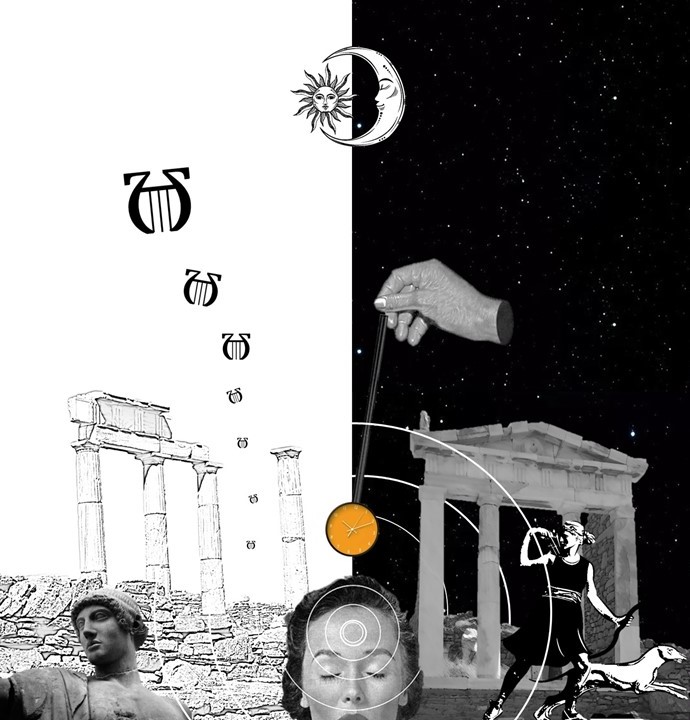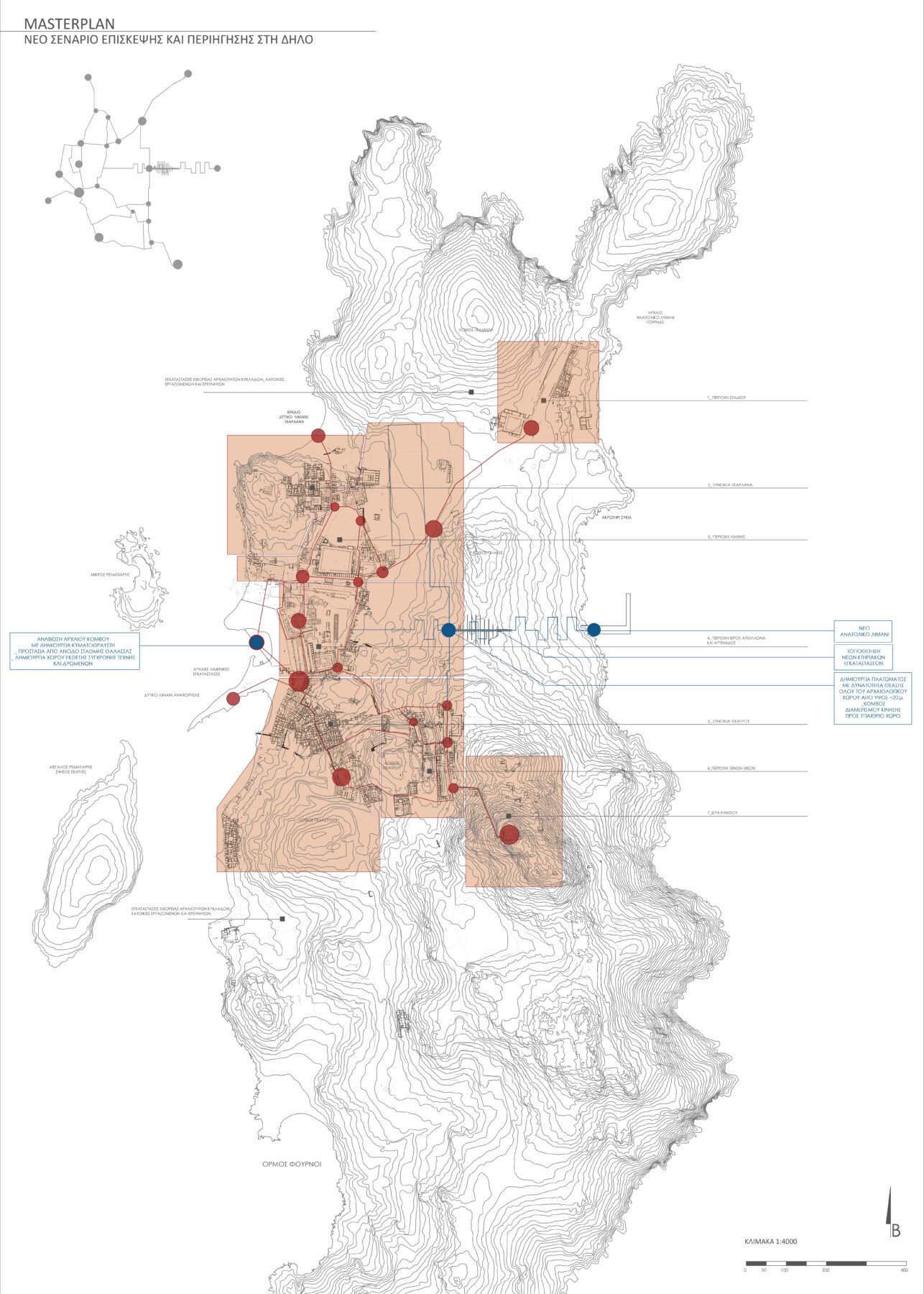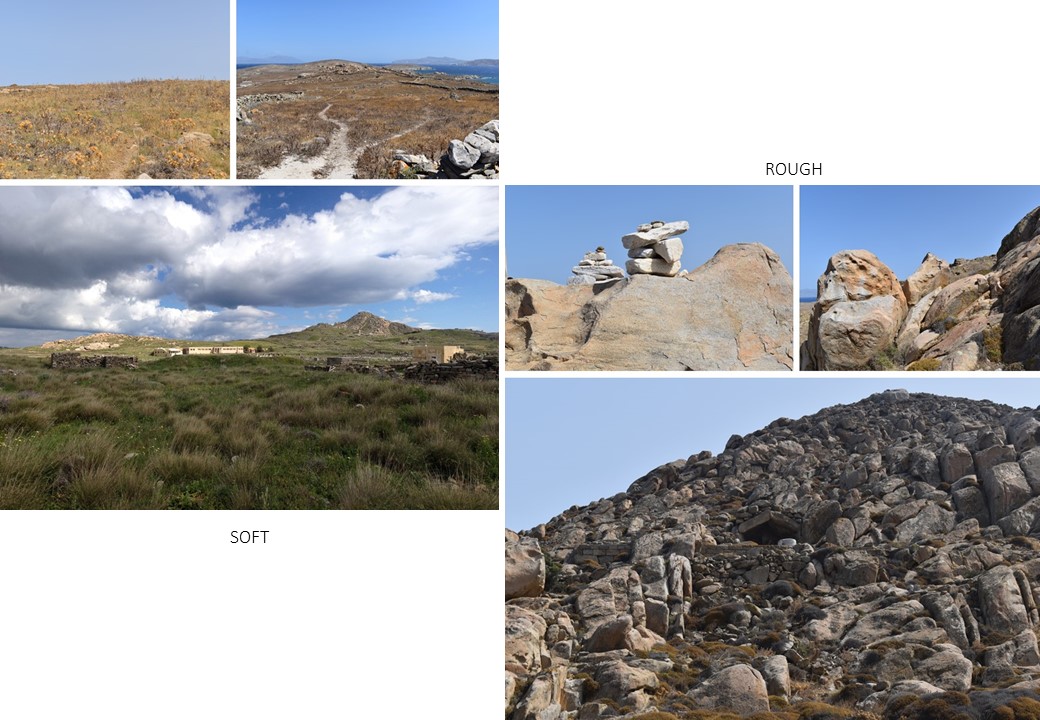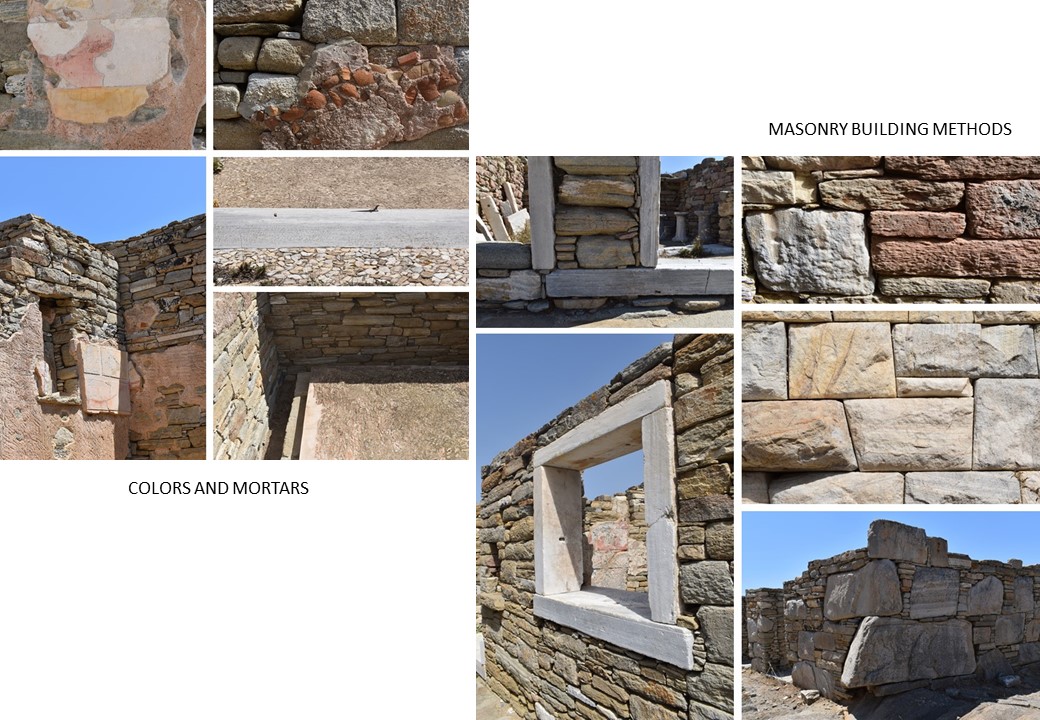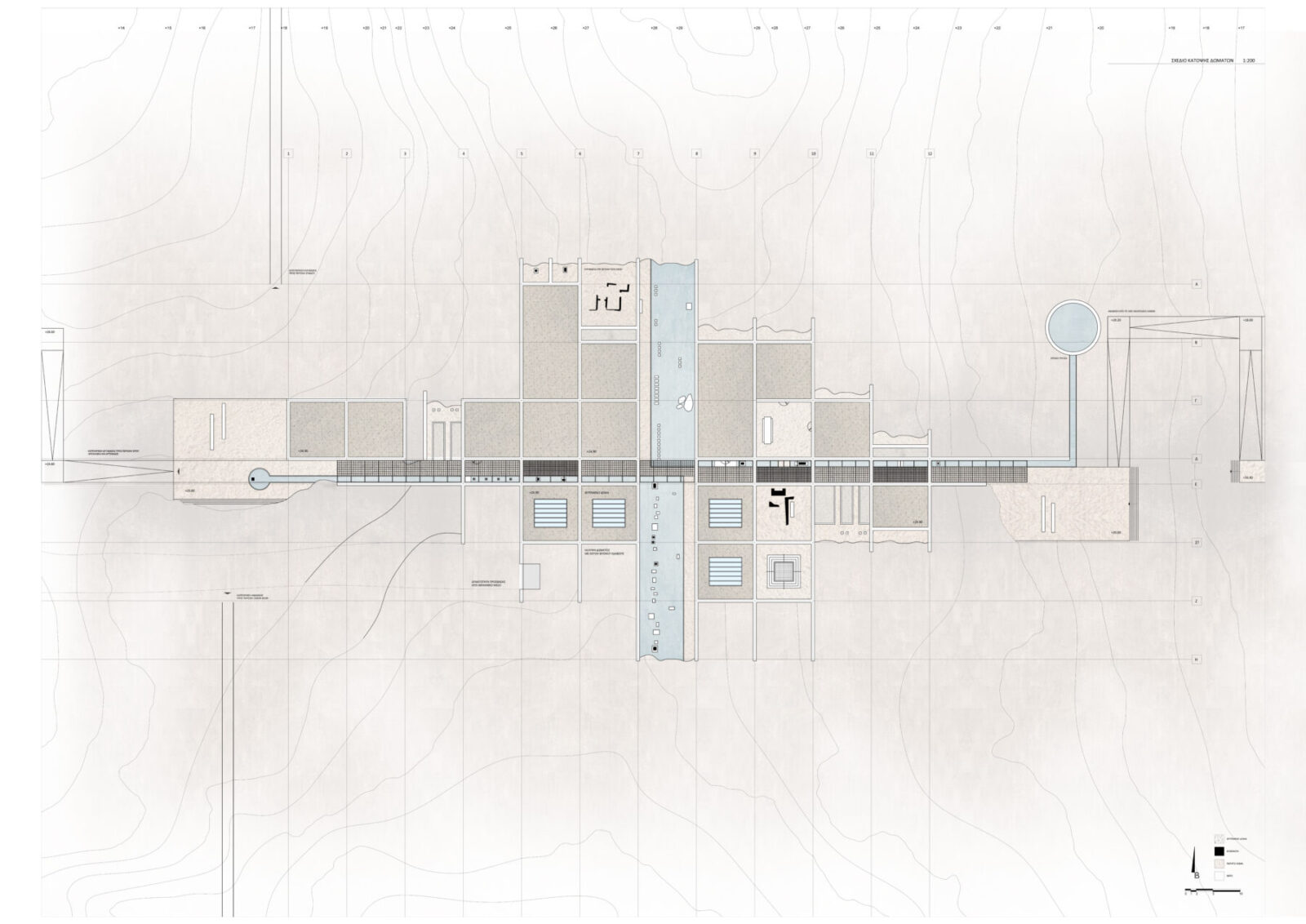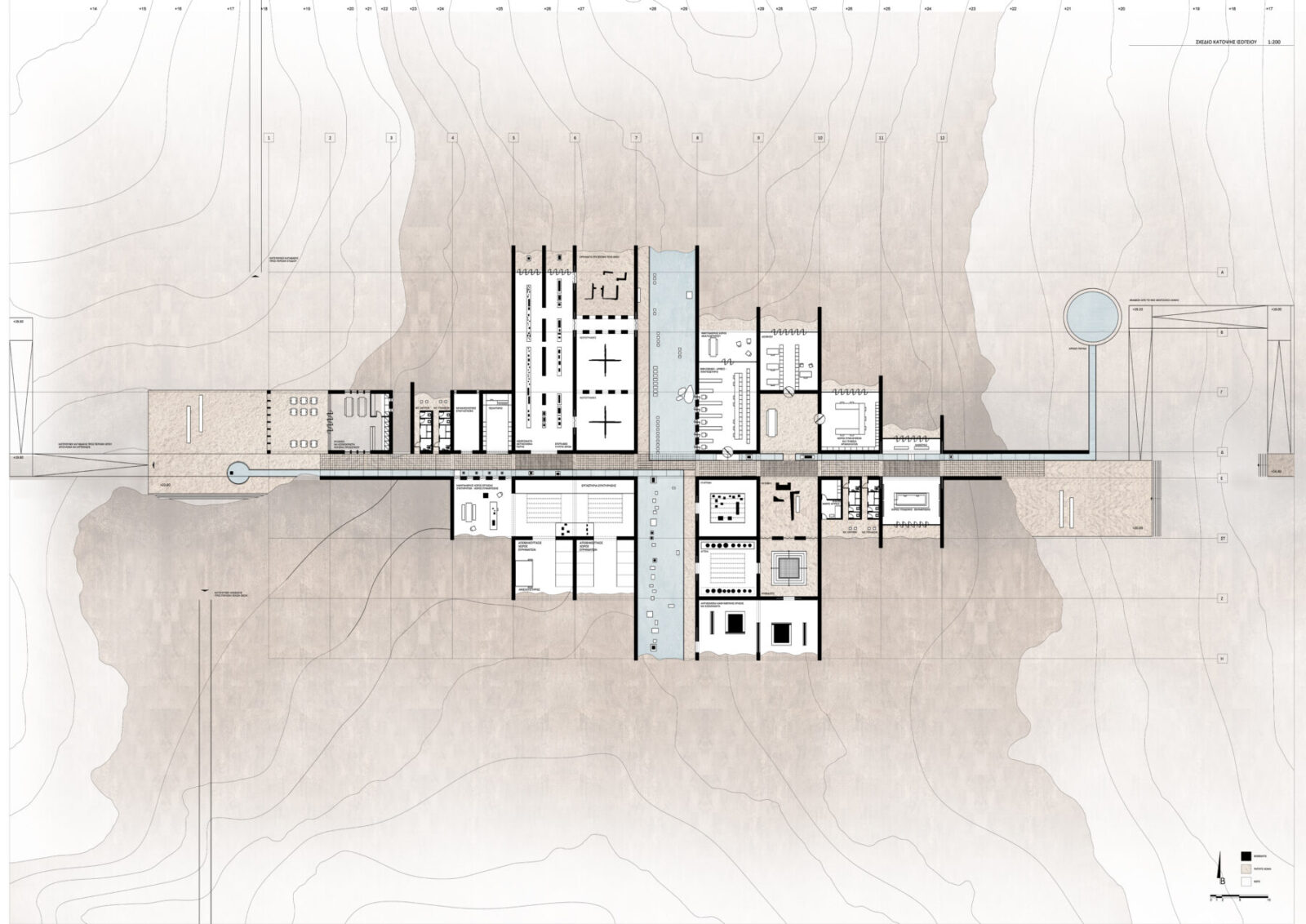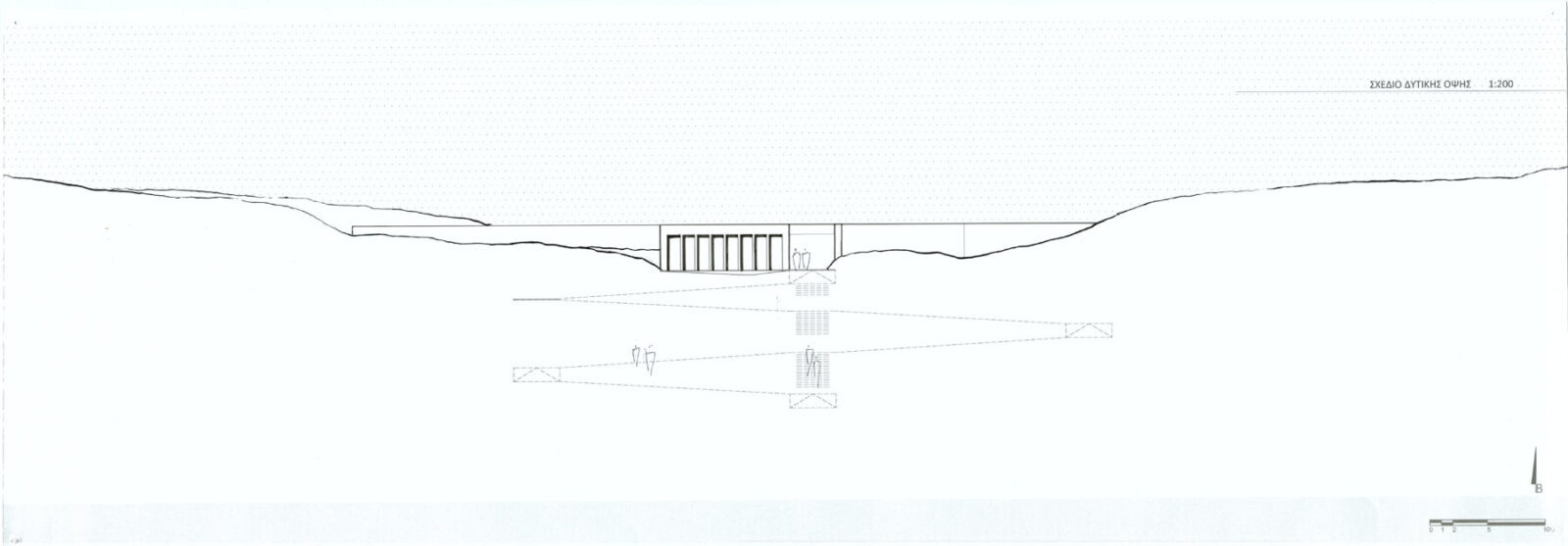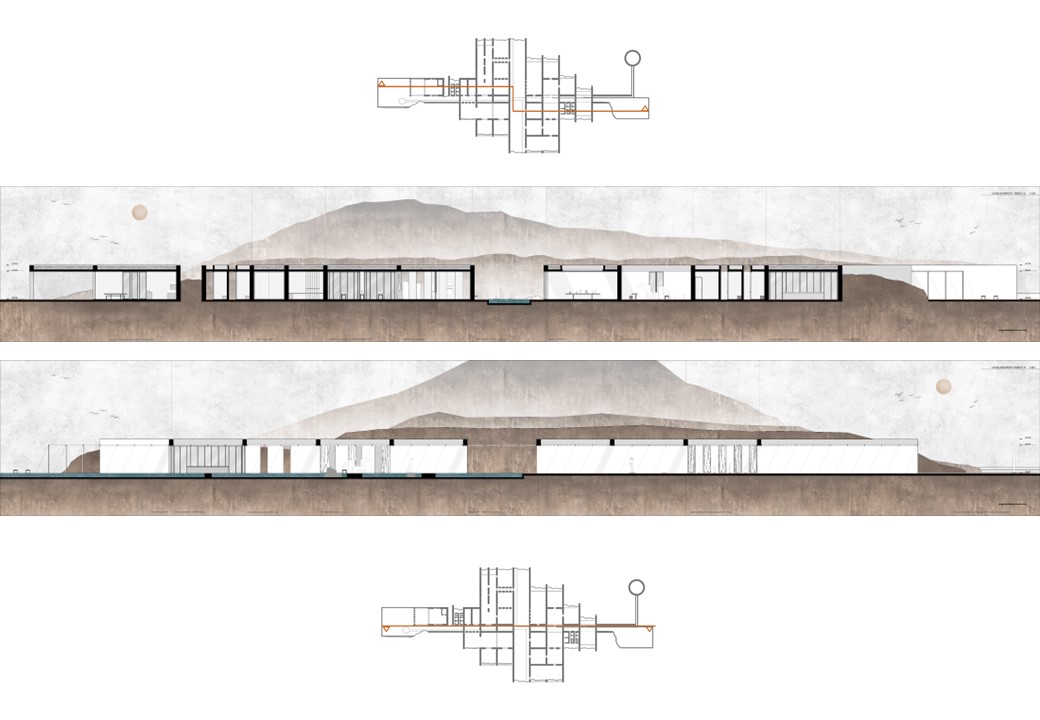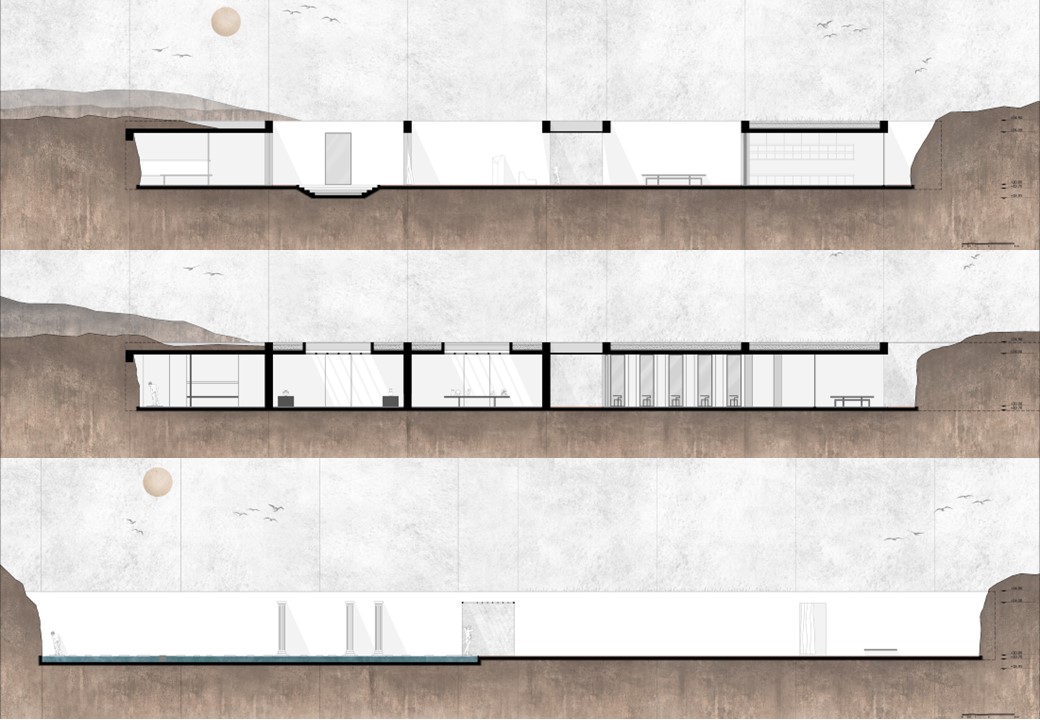Στην παρούσα διπλωματική εργασία, η Αντωνία Παπαρούπα έχοντας ως περιοχή μελέτης και επέμβασης τη Δήλο, στοχεύει σε μια πρόταση σχεδιασμού η οποία προσφέρει μια νέα χωρική και πνευματική εμπειρία.
-κείμενο από την δημουργό
Αναζητώντας αφετηρίες για μελέτη στοιχείων που θα δώσουν ουσία στην προβληματική γύρω από το «κατά πόσο η αρχιτεκτονική που συνέβη 2500 χρόνια πριν, μπορεί να αποτελεί πηγή έμπνευσης, τρόπο σκέψης και βάση σχεδιασμού στη σύγχρονη εποχή;» αποκαλύφθηκαν οι γεωγραφικές συντεταγμένες της ιερής Δήλου.
Σύμφωνα με τους αρχαίους Έλληνες και τη μυθολογία, εκεί γεννήθηκαν τα δίδυμα παιδιά του Δία και της κυνηγημένης από την κατάρα της Ήρας, Λητούς. Στο βραχώδες και ταυτόχρονα ευαίσθητο μικροσκοπικό νησί του κεντρικού Αιγαίου, αφήνει για πάντα την ενέργειά του ο Απόλλωνας και η Άρτεμης. Ο θεός του ήλιου και του νου συμβολίζει την αρμονία του σύμπαντος και του φωτός, μαθαίνει στον άνθρωπο τη συμμετρία και τη μουσική. Η θεά της σελήνης συμβολίζει τη δύναμη και την ομορφιά της φύσης, κυνηγά υπό το φως του φεγγαριού, αφήνοντας διακριτικά ίχνη.
Η Δήλος, έχει χαρακτηριστεί ως αρχαιολογικός χώρος Παγκόσμιας Πολιτιστικής Κληρονομιάς από την UNESCO το 1990.
Στην αρχαιότητα, ήταν ταυτόχρονα μια ισχυρή πολιτική δύναμη και λόγω του ιερού της, σημαντικό θρησκευτικό κέντρο στην αρχαϊκή και κλασική περίοδο. Είναι τόσο πληθωρική, ζωντανή και πολύπλοκη που καθώς τη γνωρίσει κάποιος, δύσκολα μπορεί να κάνει τη μετάβαση από τον πνευματικό στον ρεαλιστικό κόσμο.
Πολλοί επιστήμονες και καλλιτέχνες, μάλιστα, έχουν μελετήσει και εμπνευστεί από το νησί, όπως είναι ο αρχιτέκτονας και πολεοδόμος Δοξιάδης, ο ποιητής Σεφέρης και ο γλύπτης Gormley.
Η παρούσα εργασία, λοιπόν, στοχεύει να προωθήσει μια σαφή μεθοδολογική προσέγγιση βασισμένη, αρχικά στην αντίληψη του ιδιαίτερου πνεύματος του τόπου μέσα από επισκέψεις στο νησί και μελέτη κειμένων, καθώς και στην κατανόηση της αρχαίας πόλης και των κανόνων της διαμέσου αναλυτικής χαρτογράφησης βασικών πολεοδομικών και αρχιτεκτονικών στοιχείων της.
Έπειτα επιχειρείται η ερμηνεία των δεδομένων που προέκυψαν – δηλαδή της υπερφυσικής και φυσικής Δήλου ως μια ολότητα – και εν τέλει γίνεται η πρόταση σχεδιασμού διαμορφώνοντας μια εντελώς νέα χωρική και πνευματική εμπειρία.
Στοιχεία Έργου
Τίτλος έργου Ιχνηλατώντας τον ιερό τόπο της Δήλου. Η εμπειρία μιας χωροχρονικής αποκάλυψης.
Τύπος έργου Διπλωματική εργασία
Σχολή Τμήμα Αρχιτεκτόνων Μηχανικών, Εθνικό Μετσόβιο Πολυτεχνείο, 2021
Φοιτήτρια Παπαρούπα Αντωνία
Επιβλέπουσα Νικολάου Δήμητρα, Καθηγήτρια ΣΑΜ
Έτος 2021
In this thesis, Antonia Paparoupa, having Delos as her area of study and intervention, aims at a design proposal that offers a new spatial and spiritual experience.
-text by the author
Concerning the dipole ancient-modern, the question of whether the architecture that happened 2500 years ago can still constitute a source of inspiration and a design basis in modern times has aroused.
The paper aims to promote a project-oriented approach to perception, comprehension, interpretation, and place intervention in the archeological site of Delos Island.
Through a procedure of an analytical method, the current paper intends to provide some initial answers to the above question, by referring to the sacred island of Delos, the place where the universal light was born, according to Greek mythology.
A light, which can be interpreted as realistic, as a space design tool, and as an intellectual repository.
Delos, it’s a small island in the Aegean Sea, the entire island is designated as an archaeological, and a World Cultural Site since 1990 by UNESCO. In ancient times, the myth of God Apollo, God of light, and goddess Artemis having been born there rendered the island sacred: no mortal would ever be allowed to be born on its land.
This proposal introduces innovative scenario access, promenade, and intervention, in the archeological site, as well as a design approach, incorporating those critical elements focus on the understanding of the Delian Genius Loci, through the exposition of a multi-functional building complex.
The design idea is based on the perception of the place’s spirit and the analysis and interpretation of the urban and architectural vocabulary of the Delian ancient city.
The excavation is supposed to be the core design element, as an attempt to become integrated into the earth level and subsequently preserve the heavy meaning of the landscape and the balance between ancient-modern. A view threshold before visiting the open-air archeological site becomes a training tool for the visitor, through the presentation of proportions, scales, and style of the buildings, preparing him for the rest of his visit.
This kind of approach can also play a significant role in creating sensitive architectural interventions, suitable for their context, and contemporary in their design while responding to historical precedents.
It can establish a methodological tool, as a link between the fields of architecture and archaeology, which in more ways than one have a lot in common. In a time of increased awareness of issues of sustainability and heritage, the preservation of architectural landmarks of historical significance is of major importance
Project type Diploma thesis
Student Antonia Paparoupa
Supervisor Nikolaou Dimitra
University Department of Architectural Engineering, National Technical University of Athens
Date 2021
READ ALSO: ΕΣΩ 2023 Meet the speakers | Giorgos Tsolakis
